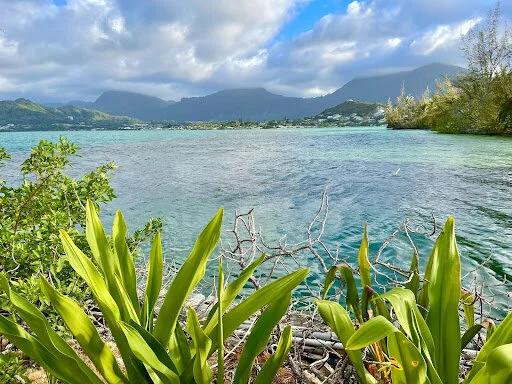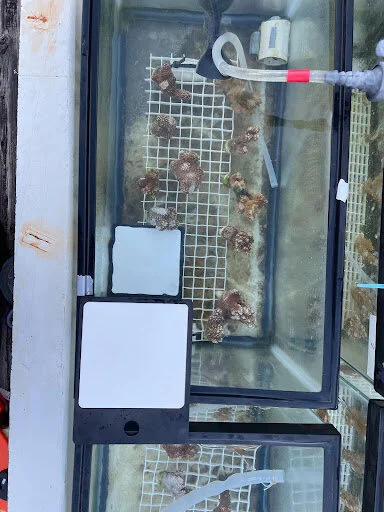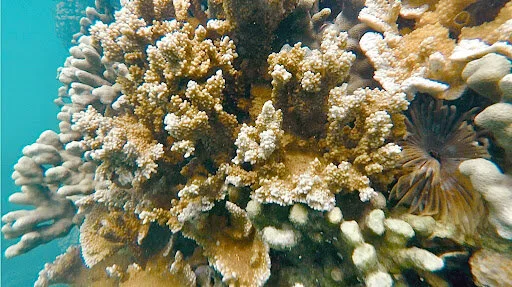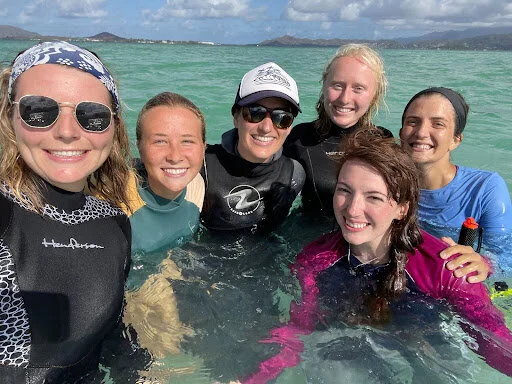Reefs and Resilience in Hawai'i
Situated in Kāne‘ohe Bay, Hawai'i, Oxford Seascape Ecology lab member Lauren Neville conducted the first-stage of her doctoral fieldwork on Coconut Island this past month. Coconut Island is home to the Hawai'i Institute of Marine Biology and offers researchers unparalleled mesocosm facilities to examine semi-controlled biology experiments with real-world exposure to natural outdoor elements, like sunshine and seawater. In collaboration with the marine ecology-focused Bahr Lab of University of Texas A&M - Corpus Christi, her research examined the stress reactions of corals within these facilities to the combined impacts of nutrient pollution and rising global ocean temperatures.
When corals are exposed to unnaturally high temperature levels, they expel the symbiotic algae called zooxanthellae living in their tissues as a stress response. This algae provides corals with their colorful exteriors and nutrition and so, as ocean temperatures rise due to climate change, the corals begin to appear ghostly white (what is referred to as coral bleaching). If the corals remain in this state, they will eventually starve causing cascading ecosystem damage. At the same time, corals are also faced with local threats including land-based nutrient pollution from sewage systems and agricultural run-off. Nutrients including nitrogen and phosphorus can cause large-scale macroalgal blooms which may overtake local reef systems causing degradation. This macroalgal growth can also outcompete the corals and cause an ecosystem regime shift from a coral dominated system to an algal dominated system. The combined stresses of both high temperatures and nutrient pollution may even be causing interacting and unprecedented damage to reef systems.
“We know that coral reefs are faced with complex threats including pollution and climate change. But we can support resilient seascape management by studying early indicators of coral health. If we can gain spatial-temporal insights on the impacts of both nutrient pollution & heat stress, we could support resilience-based policies mitigating coral reef bleaching events, degradation, & algal regime shifts.”
Lauren using a hyperspectral camera to collect reflectance and radiance data of the changing corals in the mesocosm experiment.
To better understand how global stressors, like rising ocean temperatures, and local stressors like nutrient pollution due to sewage outflows, are causing complex challenges to corals, the University of Texas A&M - Corpus Christi designed a mesocosm experiment to monitor the impacts of these stressors on a local coral species called Montipora capitata. To gather unique spectral insights into the health and resilience of the corals in the mesocosm experiment, Lauren joined the research team and used a hyperspectral camera and a spectrometer to measure both the radiance and reflectance of the Montipora capitata coral species.
In her time in Hawai'i, Lauren had the opportunity to both collect mesocosm coral data and explore the local coral ecosystem of Kāne‘ohe Bay. While working in the mesocosm, she was able to connect how small-scale biochemical reactions in corals were impacting the full reef system in Kāne‘ohe Bay. The Bay has been through countless human-environment interactions over the course of 70 years ranging from fishing, dredging, and bomb testing, to nutrient-based pollution and macroalgal blooms. However, the ecosystem has rebounded over time and now provides an ideal coral reef resilience research location. By drawing these conceptual connections, Lauren has been able to use interdisciplinary methods and novel technologies to better understand the impacts of local and global stressors on reef communities.
“This fieldwork led to a lot of insights about the local reef ecosystem, and I am excited to keep analyzing my collected data. I was also able to collaborate with exceptional faculty and students throughout my time here. After heading to Hawai’i, I am feeling hopeful that the passionate scientific community, policy makers, and local stakeholders can work together to protect our reefs for generations to come. ”




